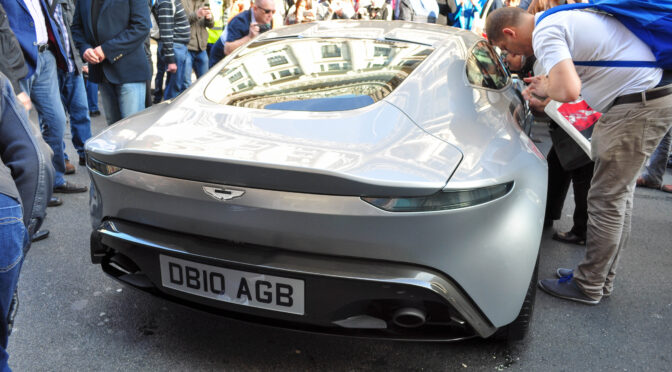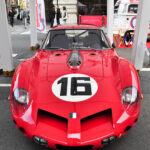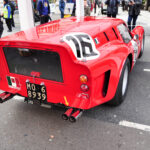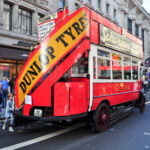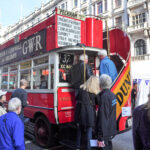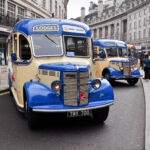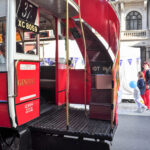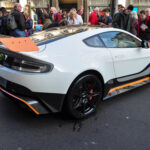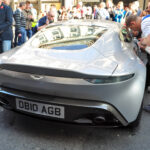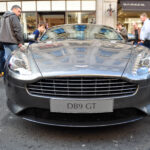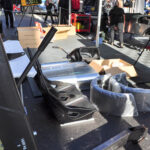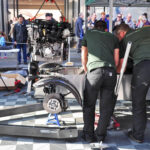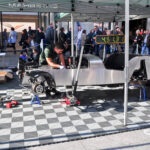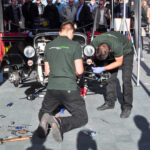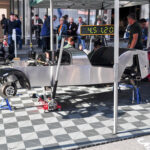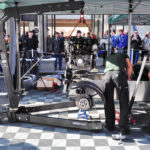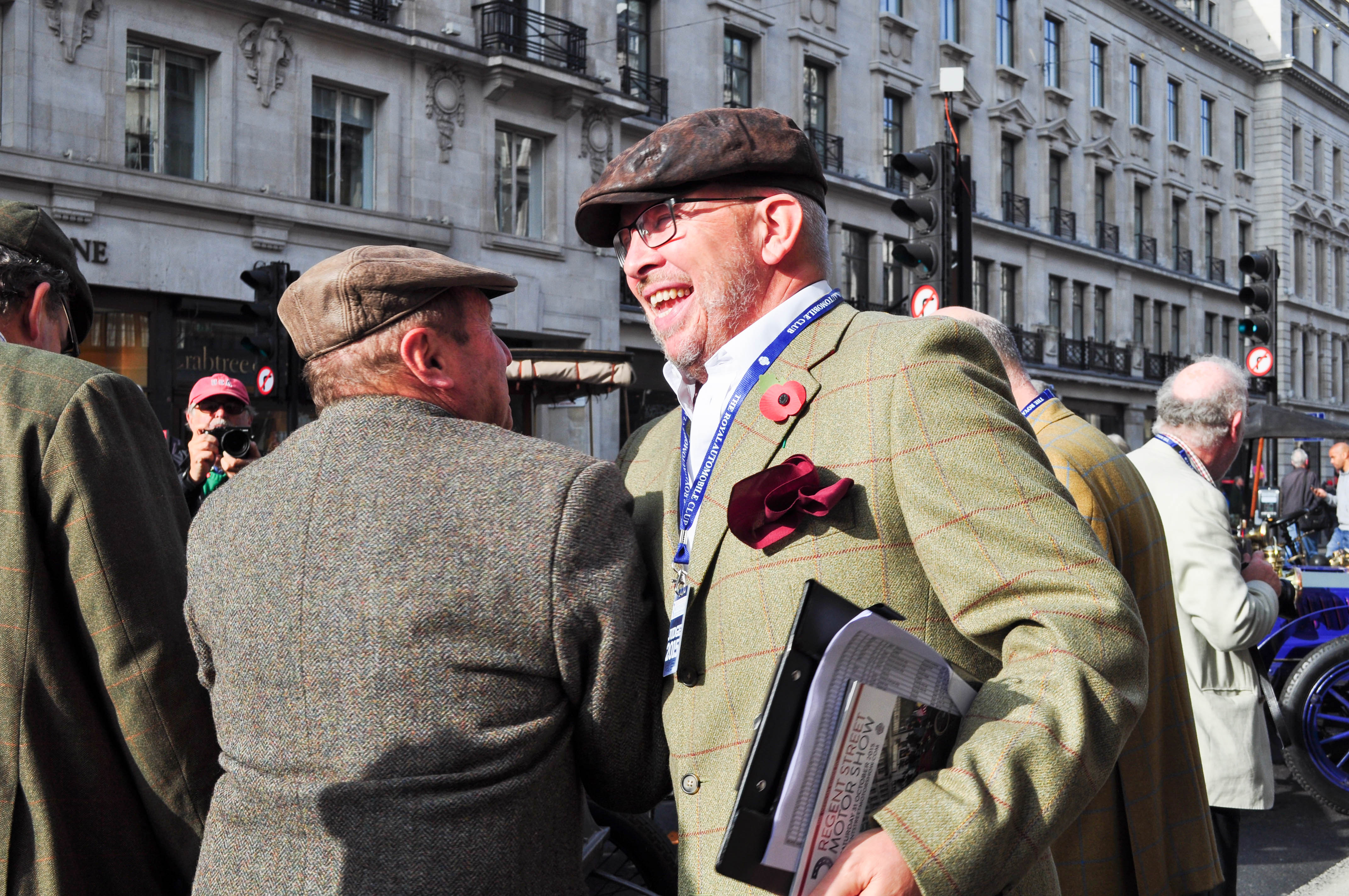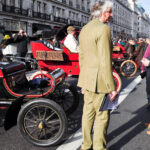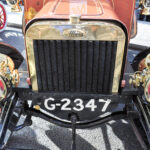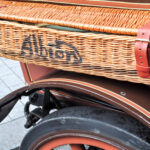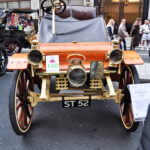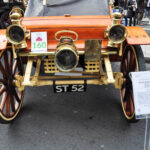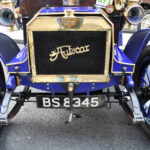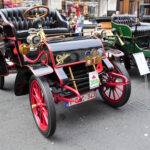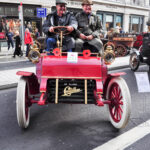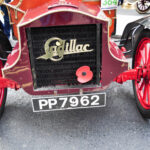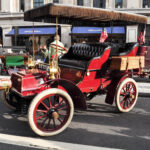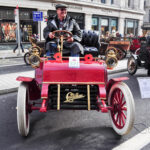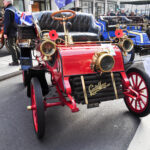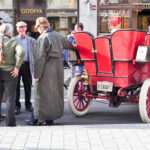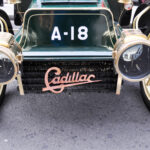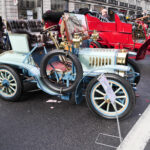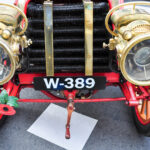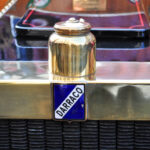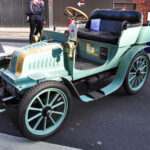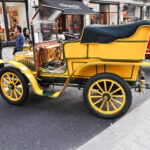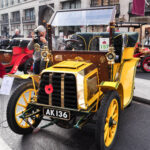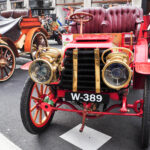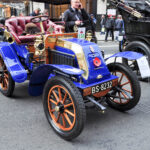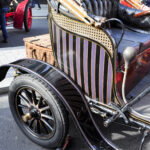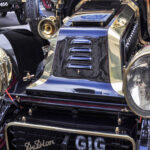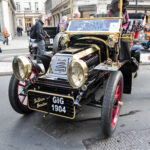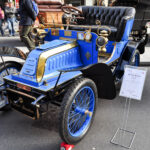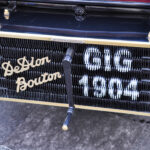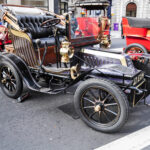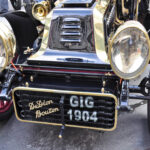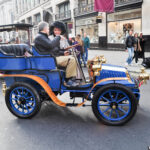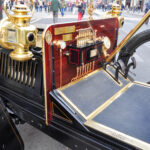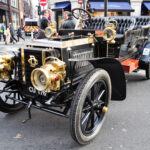(Part two of the 2015 Regent Street Motor Show has now been posted, click here to read it.)
The last day of October delivered beautiful autumnal weather and an opportunity to view a host of lovely cars (ancient and modern) along Regent Street in the heart of London’s West End.
This annual event provides superb access to great veteran cars and their period costumed custodians ahead of their participation in the London to Brighton Run. Some more modern machinery such as the latest offerings from Aston Martin and Tesla was also available for close inspection and “selfie” over-indulgence.
This is the first of two posts covering the event. Part One focuses upon more modern machinery and some of the veteran cars on display. Regent Street Motor Show – 31st Oct 2015 Part Two covers other veteran cars.
“Ciabatta Anyone?”
Popping out onto Regent Street from Piccadilly underground station and walking North towards Oxford Circus, I came across this wonderful “Breadvan” Ferrari.
This unique car has a fascinating history. It came into being as a result of Enzo Ferrari’s petulant 1961 purge of the famous five – a group of talented engineers sacked from Ferrari for the unforgivable crime of disagreeing with Enzo. Included in this purge was Giotto Bizzarrini – creator of the 250 GT and the 250 GTO.
Enzo’s venom was not restricted to his ex-employees – it also extended to long standing Ferrari customers who had the temerity to employ or associate with his ex-engineers. One such customer was Count Giovanni Volpi who’s reaction to Enzo’s refusal to sell him a new GTO was to commission his new employee – GTO designer Giotto Bizzarini to create a better version of the GTO to be raced by Volpi’s Scuderia Serenissima race team.
Using a previously raced 250 GT SWB Competition car – Bizzarrini and bodywork expert Pierro Drogo carried out a range of modifications. Bizzarini had already tried-out many of these modifications on the GTO but Volpi’s commission gave him and Drogo carte-blanche to take them even further. The modifications included:-
- Improved balance by moving the engine back towards the centre of the chassis
- Lowered centre of gravity by fitting dry-sump lubrication allowing the engine and transmission to be lowered in the chassis and also allowing a much lower bonnet line
- Improved performance by replacing the three 46DCN Weber carburettors fitted to the Tipo 168 engine with six 38 DCN Weber carburettors
- Improved aerodynamics thanks to the lowered bonnet line and the extended cockpit with Kamm tail.
After just 14 days the car was finished. It was lower, lighter (by 65kg) and faster than the Ferrari GTO but its rather brutal extended cockpit and Kamm tail resulted in French observers saying that it looked like a bread delivery van or “Camionette”. In Britain it was referred to as the “Breadvan”!
” You wait ages for a bus – then they all come along at once!”
Bus Spotting is one area of automotive interest that’s eluded me – a situation that’s unlikely to change.
It was however quite nostalgic to see some of the old buses on display at opposite ends of Regent Street. A couple of them even pre-dated me!
The old 1920’s open top double decker resplendent in its period advertising logos had a wonderfully elegant spiral staircase to the top deck from the hop-on/hop-off rear deck.
Aston Martin
The little gaggle of Aston Martins attracted an inordinate amount of the Regent Street crowd’s interest – mainly because it included the latest James Bond DB10.
It was photography frenzy with people frantically thrusting all manner of cameras, smartphones and tablets into the melee in an attempt to snatch “exclusive” photos of the car or more accurately “exclusive” photos of themselves, friends, family, progeny and pets in front of the car.
The DB10 was developed especially for its starring role in Spectre – the latest James Bond film. It’s nice that the continuity of association between Aston Martin and the Bond franchise has lasted for over 50 years from1964 when the delectable and tooled-up DB5 featured in Goldfinger as the wheels for Sean Connery’s 007.
We’re told that the car’s designer Marek Reichman worked closely with Sam Mendes and Barbara Broccoli – respectively director and producer of Spectre during the creative process but Aston Martin have also hinted that the DB10 provides a glimpse of their design direction in the years to come.
NB: It’s a nice twist of fate to have another Marek involved in Aston Martin design. Sheffield born Marek Reichmann follows in the footsteps of Tadek Marek – the Polish engine designer responsible for the straight-six engine used in the DB4, DB5 and DB6 and the subsequent V8 engine.
As regards the DB10 oily bits – the car uses a lengthened V8 Vantage chassis to extend its wheelbase and overall proportions are kept in balance trough the car being made wider than current models. It’s powered by the 4.7 Litre V8 engine from the Vantage and this is mated to a 6-speed manual gearbox.
Only ten DB10s will be built, so it’s fair to say that they’re set to become highly exclusive and desirable future classics.
NB: None of my family, friends or my pet squirrel Cyril were used in the making of this Aston Gallery!
Modern Electric Cars
In amongst the veteran and classic cars on show – there was a collection of modern electric cars on including the Tesla and BMW iPhone8 (its only a matter of time).
Devoid of the reassuring aroma of petrol I gave them a wide berth!
Caterham 7
How to make a perfect Caterham 7:-
- Gather all of your ingredients – body shell, wings, bonnet, suspension & braking components, seats, engine, gearbox, wheels & tyres
- Scatter them liberally across the top-end of Regent Street
- Find a crack team of car builders
- Point the the car builders at the ingredients telling them they can’t go to the pub until the car is fully built and running
- Season with occasional beverages & snacks
- Gently simmer in Autumnal sunlight for 5 hours
- Hey Presto – you have your perfect Caterham 7
- Well you would if I’d bothered to hang around for 5 hours!
Seriously though – Caterham advise buyers of their self-assembly cars that they’ll need to set aside 80 to 100 hours labour to fully build up the vehicle. Doing in under five hours is simply phenomenal.
VIPs Among The VETs
Whilst wandering around Regent Street I managed to spot Ross Brawn of F1 fame and Ed China – arch Wheeler Dealer. Both seemed to be involved in judging the Concourse Competition cars and being togged out in traditional tweeds – they looked the epitome of English country gentlemen.
After a highly prolific career in the extremely fast lane of Formula 1 engineering and team management – Brawn has gone back to his automotive roots with a 1904 Wilson Pilcher in which he participates in the London to Brighton Run.
Veteran Cars – A to D
The main event in the Regent Street Motor Show is the veteran cars lined up in all of their splendour a day before their annual pilgrimage to Brighton.
These cars date back to the dawn of motoring and are living breathing monuments to the invention and ingenuity of long dead engineers, designers and entrepreneurs.
Looking into the background of these cars throws up some remarkable similarities and interesting cross linked stories.
It’s quite remarkable for example how many car manufacturers grew out of previously successful bicycle manufacturing businesses.
Others new car manufacturers rose out of the ashes of predecessor companies which failed due to business mis-management or design dissent.
The cars also provide evolutionary insight into how particular mechanical features that we now take for granted in modern cars came to be invented and proven on public roads and on the very first race tracks. The corollary of course is that some cars also demonstrate evolutionary cul-de-sacs!
Here are just some of the marques on display:-
Albion
The Albion Motor Car Company Ltd was founded in Glasgow in 1899 by Thomas Blackwood Murray and Norman Osborne Fulton – both of whom had both previously been involved with Arrol-Johnston (another Glasgow car manufacturer).
From 1900 (before moving on to concentrate on the manufacture of trucks and buses) the company built a number of Albion cars or Wagonettes at their factories in central Glasgow and then in Scotstoun.
Like the Arrol-Johnston – the Wagonette featured lots of wooden panels and it retained a rather utilitarian look befitting its model name. This particular car was powered by the 3115cc 16HP twin-cylinder engine which was introduced in 1903.
Arrol-Johnston
This car company was formed out of a joint-venture established in 1895 between Sir William Arrol (a Scottish engineer who built the Tay Bridge and Forth Bridge in Scotland and Tower Bridge in London) and George Johnston (a fellow Scot and former railway engineer).
Initially established as the Mo-car Syndicate – cars were built in Calmachie in Glasgow and later in Paisley. In 1902 William Beardmore secured a controlling share of the company and he eventually pulled in J.S. Napier to take on the role of chief engineer vacated by George Johnston. Arrol-Johnston later came up with such innovations as a 4 wheel braking system!
This dogcart dates from the time that Johnston was still in place as chief engineer and it clearly show the liberal use of wood in the bodywork.
Autocar
Founded in 1899 in Ardmore, Pennsylvania by the talented mechanical engineer Louis Semple Clarke – Autocar established 2 long lasting automotive standards:-
- All Autocars were built in left hand drive form and this established this as a standard in the USA and most of the rest of the world except the last bastions of civilisation in the UK, Japan, Australia, New Zealand and South Africa
- A patent was established for porcelain insulated spark plugs which became standard fitment in all internal combustion engines. The patent was later sold to Champion
This 1904 Tonneau featured a flat twin 12HP engine and 3-speed transmission.
Cadillac
Long before the famous fins, rocket shaped lights and acres of chrome that typified ’50s and ’60s Caddys – the company was churning out single cylinder engined Tonneau and Runabout cars from 1902.
Cadillac is named after Antoine de la Mothe Cadillac – a native Frenchman who founded the settlement of Fort Pontchartrain du Détroit in New France. The settlement eventually grew into Motor City – Detroit.
Strangely – Cadillac came into being in 1902 as a result of a dispute between Henry Ford and the investors of the Henry Ford Company. The dispute led to Henry Ford leaving the company and Henry M. Leland of Leland & Falconer Manufacturing was brought in to assess the remaining plant and assets. Seizing this opportunity Leland restarted the plant to manufacture cars using his single cylinder engine and badged Cadillac. In doing so – Leland established the long standing company reputation for precision engineering.
The large number of Cadillacs present on Regent Street bore testament to Caddy build quality.
Century
The Century Motor Vehicle Company enjoyed a brief existence between 1899 and 1903 during which time its factory in Syracuse, New York churned out electric, steam and internal combustion engine powered cars.
The multiple founders of the company (Charles F. Saul, William Van Wagoner, Charles Listman, Charles A. Bridgman and Hiram W. Plumb) were all connected through their involvement in the Barnes Bicycle Co. It was Van Wagoner and Saul who adapted their bicycle design skills to create a prototype car in 1899. Initially called the Van Wagoner this formed the basis of the Century cars to follow.
Century car manufacture began in earnest shortly thereafter with steam and electric powered runabouts with the steam cars utilising an advanced shaft drive to the rear wheels instead of the then conventional chain drive.
Following the trend to move away from steam and electric power – Century cars adopted single cylinder 7HP internal combustion engines from the beginning of 1903. This car – the Century Tourist attracted a great deal of public attention and gave the company a full order book but unfortunately company finances were in very poor shape and control was passed to its large number of creditors before the company was declared insolvent in 1904.
Interestingly the car on show dating from 1904 has a two-cylinder engine but little is known about the car other than it is believed to be the only surviving 4 wheeled Century car.
Clement
The rags to riches story of Gustave Adolphe Clement-Bayard is quite staggering. Orphaned at nine years old – he moved from grocery delivery boy to apprentice blacksmith to bicycle manufacturing and bicycle racing.
Combining small engines with bicycle and tricycle frames inevitably led him into building cars and in parallel he secured the French manufacturing rights for Dunlop pneumatic tyres which quickly gave him millionaire status.
Working with a variety of partners – Clement-Bayard created cars badged as Clement-Gladiator, Clement-Panhard, Clement-Bayard, Clement-Rothschild, Clement-Stirling, Clement-Talbot and Diatto-Clement.
In addition to road cars – Clement-Bayard produced successful race cars from 1904 but involvement in racing was curtailed following the death of his son Albert Clement whilst practising for a race in 1907.
Interest then shifted to aviation and Clement-Bayard started to build aircraft engines and then complete planes as well as airships. Quite a story of a true entrepreneur.
This particular car originated from France before making it’s way to Switzerland via Holland.
Darracq
Founded in 1896 in Suresnes on the outskirts of Paris by Alexandre Darracq the company was born out of bicycle manufacturing but then moved into building motorcycles, cycle-cars, cars and aircraft engines.
Darracq branches were quickly established around Europe with the British one eventually (in 1935) subsuming its parent into the Sunbeam-Talbot-Darracq conglomerate.
The company’s first Voiture Legere cars were produced in 1900 soon to be followed by a range of models sporting single, twin and four-cylinder engines.
Alexandre Darracq was keenly involved in racing his cars from 1901 with the marque achieving a number of class successes in such races as the 1902 Paris-Vienna. In 1905 Darracq also created a 22.5 Litre sprint car monster by using two siamesed four-cylinder blocks to create an overhead valve V8. This 200HP car set various speed records culminating in 117.66 mph at Ostend in 1906.
A number a beautiful Darracq cars were on display on Regent Street including the evergreen (or should that be ever green) Genevieve.
Deckert
A great deal of mystery surrounds this particular marque which was named after its founder Henri Deckert of Paris.
Monsieur Deckert seems to have dabbled in motoring related matters from 1897 in a variety of ways such as repairing cars and tricycles, offering performance enhancements for car and motorcycle engines and competing in various French road races of the period.
At some point he started building his own cars but precisely how many he built is unknown. It is known that he raced one of them in 1902 but the only known surviving example of the marque is the 1902 864cc single cylinder 8hp model pictured below.
De Dion Bouton
Originally established in 1883 in Paris as De Dion, Bouton et Trepardoux – the company became De Dion Bouton in 1894 after Charles Trepardoux resigned in protest at the company consolidating on internal combustion engines instead of steam.
This left the Marquis Jules-Albert de Dion and Georges Bouton to grow the company into the largest automobile manufacturer in the world by 1900.
Like many of their contemporary early car manufacturers – De Dion Bouton recognised the benefits of participating in car races both from a marketing perspective and for rapid mechanical development and testing of features that would eventually find their way into their road cars.
Single cylinder De Dion Bouton cars featured in races such as the Paris-Berlin in 1901 and by 1903 – De Dion Bouton fielded 3 Litre four-cylinder 18hp Voitures Legeres. Rather tellingly – road going four-cylinder cars only followed in 1905 by which time the engine was deemed to be sufficiently developed for use by the buying public.
For one year only (1901) De Dion Bouton cars were made under license in Brooklyn, New York.
During the early 1900s the company prospered not only from the cars and trucks it manufactured but also from the enormous amount of engines used to power other vehicles.
Delahaye
Founded by Emile Delahaye in 1894 in Tours in the Loire Valley Delahaye cars rapidly established themselves and so Emile was able to draw in additional funding to form Society Des Automobiles Delahaye.
Ill health forced Emile to sell his shareholding to investment partners George Morane and Leon Desmarais in 1901 and Emile sadly died in 1905.
Early Delahaye race successes helped establish the company but Emile was the driving force behind the racing programme and it inevitably declined following his death.
The car below is presumably from early 1902 as single-cylinder cars were supplanted by twin-cylinder versions that year and both were replaced by for cylinder engines in 1903.
Delaugere et Clayatte
Initially established in 1864 as Delaugere by Jean-Pierre Delaugere in Orleans the company under sons Henri and Emile eventually merged with the Clayette brothers from Meung-sur-Loire.
The merger coincided with Delaugere et Clayette starting to build their own engines to power their increasingly luxurious cars.
The fine build quality of these cars can be seen in this wonderful example from 1904. With its beautiful button-backed upholstery – it’s like an exclusive Gentleman’s Club on wheels!
